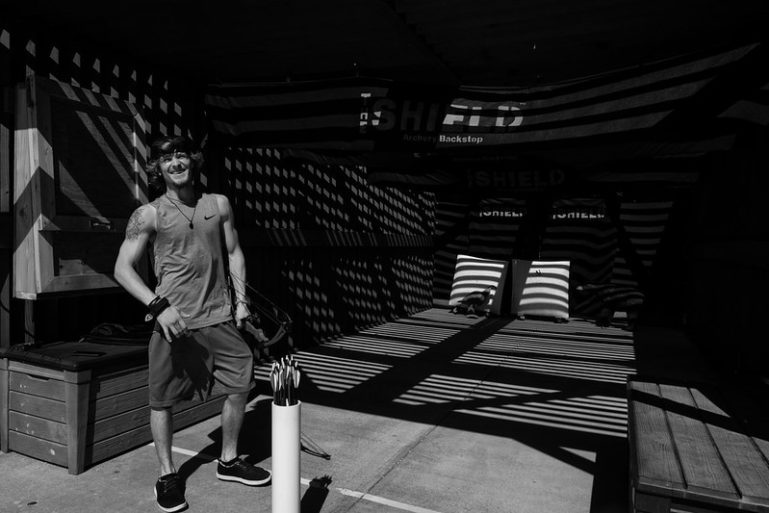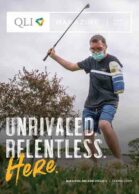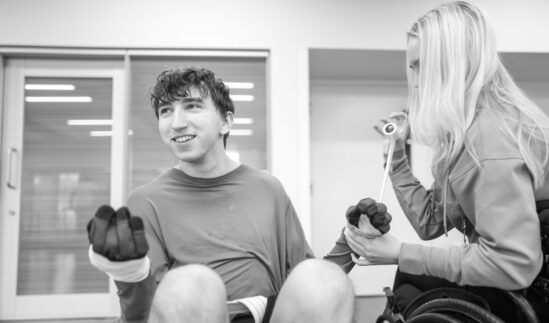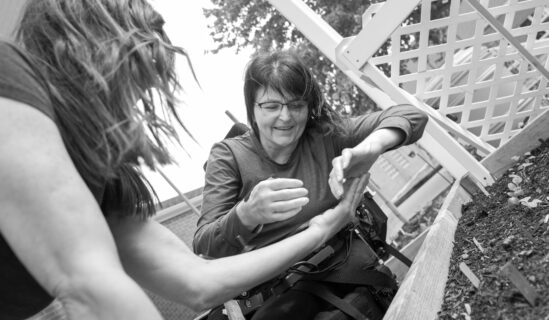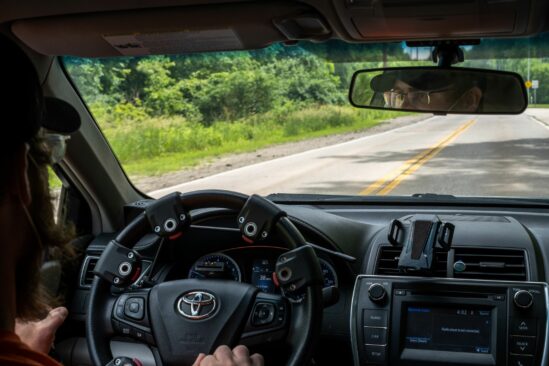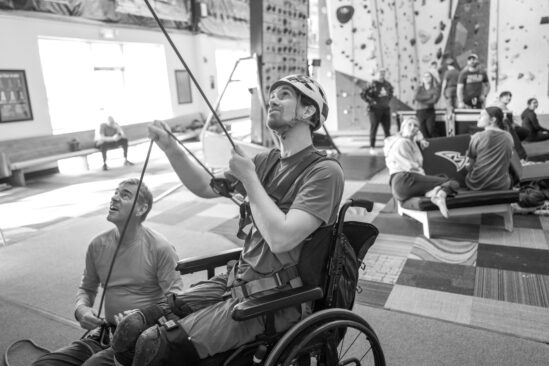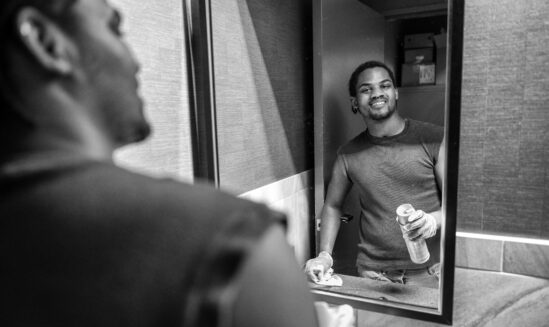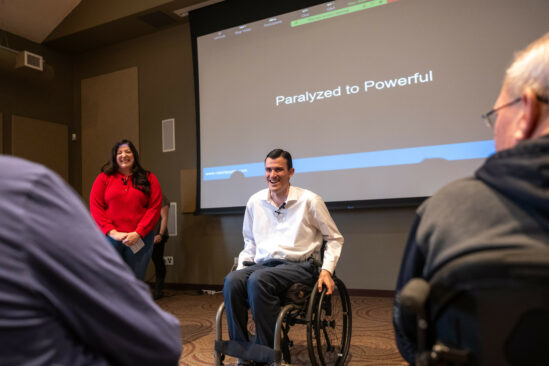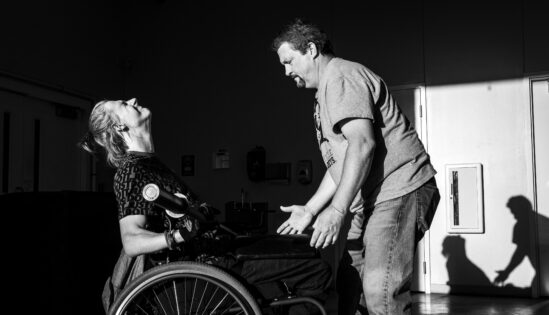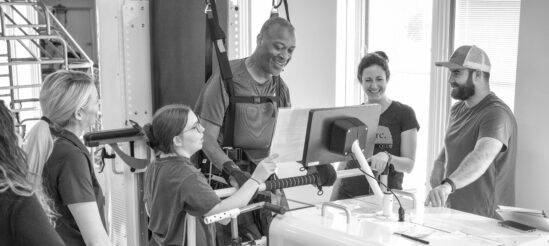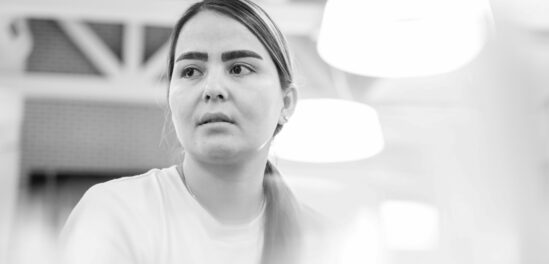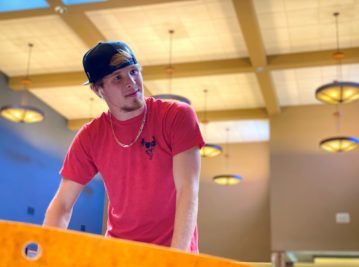 It isn’t ten minutes before a small crowd starts to mass around Cole Davenport, here in the high-ceilinged atrium of QLI’s Colladay Center, where he’s laid an off-white posterboard and spilled more than three dozen photos over the breadth of one of the lobby’s meeting tables. The posterboard is wider than a doorframe. And the photos include a mix of snapshots Cole himself captured—photos of himself at a time before he ever knew what QLI was. Photos of his mother and uncle. Photos, too, of his early days at QLI, the days when he was still processing everyday life from the seat of a wheelchair.
It isn’t ten minutes before a small crowd starts to mass around Cole Davenport, here in the high-ceilinged atrium of QLI’s Colladay Center, where he’s laid an off-white posterboard and spilled more than three dozen photos over the breadth of one of the lobby’s meeting tables. The posterboard is wider than a doorframe. And the photos include a mix of snapshots Cole himself captured—photos of himself at a time before he ever knew what QLI was. Photos of his mother and uncle. Photos, too, of his early days at QLI, the days when he was still processing everyday life from the seat of a wheelchair.
Months have passed since those photos were taken, evidenced in no uncertain terms by his ability to stand over the table and survey its scatterings from above. He’s traveled back home to Missouri since the date of those photos. Returned a second time to Omaha, too. Back to QLI with the understanding that recovery from a spinal cord injury means more than regaining sheer physical potential.
The 23-year-old looks at Jaime Johnson, one of the specialists from Cole’s Life Path Services team, who sits on the far side of the table. Cole doesn’t say anything when they meet eyes. But he waits as if for some show of permission.
“This isn’t about me,” Jaime says. “This is all you.”
Cole nods, reaffirmed. He groups like images together in discrete zones on the posterboard. Monochrome workout portraits line the bottom fringe. Pictures of future possessions—the house he hopes to buy, the motorcycle he hopes to ride—get squared tightly into the top corner. The photos of his family and friends, he moves to the right-most edge. He puts an action shot of Kansas City Chiefs quarterback Patrick Mahomes dead center, a picture Cole himself scissored out from an old magazine.
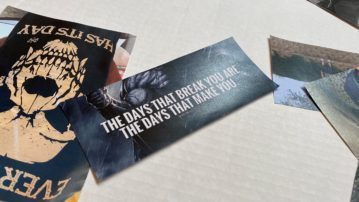 Left unplaced for now is a stack of inspirational quotes. Motivational phrases. They each have their meaning, but Cole keeps them collected by his side. On the board, white space remains empty, but the phrases lack a fitting home.
Left unplaced for now is a stack of inspirational quotes. Motivational phrases. They each have their meaning, but Cole keeps them collected by his side. On the board, white space remains empty, but the phrases lack a fitting home.
This collage exists as more than a simple mental exercise. It’s the start of a vision board, a tangible representation of Cole’s trajectory—not just as someone who has survived a catastrophic injury, but as a young man forging a new path into independent adulthood.
The project is soon to anchor all of Cole’s therapy programming at QLI, an exhaustive reclamation effort that began months earlier, in February 2020, when the then-window factory worker was crushed under five panes of glass.
But a more immediate purpose is being served here, too. The vision board is a totem, a waypoint. A recurring source of motivation for Cole when tough days hit hardest and the next footholds seem out of reach. In simple terms, it’s a constant reminder—for what all his grueling effort, all the countless hours in the weight room and months of structured therapies, is supposed to give in return. Something more than function:
Confidence.
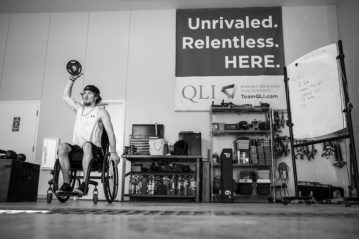 “Our goal is to reframe Cole’s internal dialogue,” Jaime says. Plying a background in psychology, Jaime operates as one of Cole’s many coaches. He’s both an expert in practical mindfulness and a voice of clarity for the young rehabilitation client. When Cole needs it, Jamie helps sketch the map of this forward-moving path.
“Our goal is to reframe Cole’s internal dialogue,” Jaime says. Plying a background in psychology, Jaime operates as one of Cole’s many coaches. He’s both an expert in practical mindfulness and a voice of clarity for the young rehabilitation client. When Cole needs it, Jamie helps sketch the map of this forward-moving path.
“Recovery is like any process of learning,” Jaime says as Cole puzzles images into place. “You have to go through the learning process being willing to see mistakes as data points, not as failures.”
The road back from a spinal cord injury, especially from one as gruesome as Cole’s, is difficult to quantify. More difficult, perhaps, to forecast. Watching Cole today, an outwardly healthy, visibly athletic young man who now walks with only the light assistance of a single-point cane, it can be hard to imagine how bleak and uncertain things were in the shadow of his accident.
Back in February, doctors assessed the burst fracture in Cole’s lumbar spine, the point at which he sustained the most damage and beneath which he lost most of his coordination and strength. After emergency surgery, those same doctors estimated he had—at best—a coinflip’s chance at walking again. For the next two months, Cole was confined to a wheelchair, fighting through excruciating pain and standing only for brief moments.
In many respects, the cruelest effect wasn’t physical at all. The trauma spiked Cole’s anxiety, overwhelming his ability to articulate words. His speech became characterized by verbal dysfluency—irregular, often involuntary repetition of sounds and syllables. Every sentence he tried to verbalize slammed to a halt. He would try breathlessly, time and time again, to push words past his teeth. But for every repeated attempt, his efforts met failure.
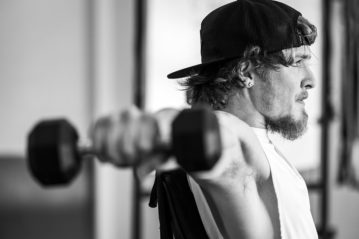 Speaking itself became a frustrating, defeating reminder of the changes he had endured. He apologized to anyone he wanted to interact with, fearing judgment or perhaps even the notion that he had wasted someone’s time.
Speaking itself became a frustrating, defeating reminder of the changes he had endured. He apologized to anyone he wanted to interact with, fearing judgment or perhaps even the notion that he had wasted someone’s time.
At QLI, where he arrived in late-March ready to participate in specialized therapy, Cole was surrounded not only by expertise and technology, but by passion and, likewise, compassion.
His clinicians understood physical progress meant little in a vacuum. Cole’s emotional and psychological well-being required support to the same degree. He needed an environment that reinforced his value, a relentless system of empowerment that could change not only his recovering physiology, but his wounded self-esteem.
They knew finding Cole’s voice meant finding Cole’s purpose.
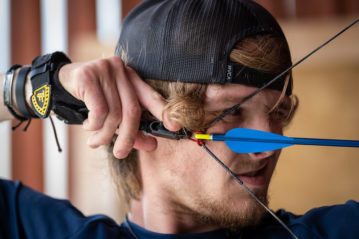 Purpose first arrived as an arrow nocked to a bowstring: Archery.
Purpose first arrived as an arrow nocked to a bowstring: Archery.
Introduced to the sport by Jack Mahaffey, QLI’s adaptive sports specialist, Cole discovered a newfound love—something that challenged his returning lower body muscles and encouraged him to maintain a singular focus.
He’d never fired a bow before in his life. But suddenly the range was where he dedicated all his free time. Sometimes he snuck out between physical therapy sessions, and sometimes he spent the summer evenings there, he and Jack, just shooting arrows when the rest of QLI’s campus had wound down operations.
Cole absorbed everything about the sport like a sponge. How to stand with stability, how to sight the target, how to self-correct when shots trend in one direction.
But archery wasn’t some simple hobby. It had revealed a peculiar kernel of Cole’s character: He loved to teach. And as Jack brought other rehabilitation clients to the archery range, it was often Cole, not Jack, guiding newcomers through the process of firing at a target. Helping support others’ weakened muscle groups, posing as an example of proper shooting form, and, indeed, speaking clearly.
This was revelatory. Here, laid bare, was all the evidence Cole needed to rebuild his shattered confidence. Here, as obvious as a bullseye, was Cole’s forward path.
Today, little more than seven months after his injury and after six months of sustained training at QLI, Cole is walking again. He’s back behind the wheel, making deliveries on the rehabilitation campus when mail arrives each day. He’s building vocational skills, which occasionally means helping the maintenance and groundskeeping teams with workplace tasks—like sanding a freshly repaired picnic table—and sometimes means sitting down behind a computer to write a resumé.
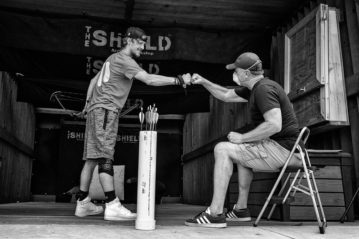 But now, being an inspirational figure in others’ lives is central to Cole’s day-to-day life. It’s where he uses a rediscovered voice.
But now, being an inspirational figure in others’ lives is central to Cole’s day-to-day life. It’s where he uses a rediscovered voice.
“I’ve made it my mission to help people unlock who they are,” Cole says. “I want to show people who they’re meant to be. It’s important to know that there’s always someone there for you, especially when you think you’re at rock bottom.”
In response, his rehabilitation program has pivoted to give him practice as a focused mentor. On top of leading archery seminars with Jack, he spends multiple sessions every week working alongside a fellow rehabilitation participant, one working to recover from a traumatic brain injury.
The Cole Davenport of September 2020 strikes a sharp contrast to the Cole Davenport who arrived at QLI in March, the one still overwhelmed by the scope of recovery ahead. He’s the first to admit not every day is easy. But, today, he’s the first to stand up to a new challenge, even if it means missing the proverbial target altogether.
“It’s a lot like shooting arrows,” Cole says, talking at once about the hard work of rehabilitation and, between the lines, some broader notion of leading a life worth living.
“Some days you’re just on. Hitting everything. Other days you have to dial it in. You just have to keep going.”
He adds, “It’s all a mind game. You choose to slump or choose to rise up. I know what I choose every day.”
Back at the vision board, Cole holds a quote in his hands—an image, like others here, cut from a magazine page.
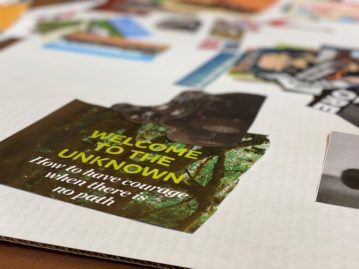 “Welcome to the unknown. How to have the courage when there is no path,” its big, blocky typeface reads.
“Welcome to the unknown. How to have the courage when there is no path,” its big, blocky typeface reads.
He weighs the statement over the empty space on the posterboard, a space he’s tentatively reserved for all of the quotes lumped together. And yet, the more he contemplates this plan the less any of it feels right.
There was an order to life before. A structure. It made sense in that logical way. He remembers waking up early, driving to work for his eight-hour shift at the window factory, making the drive back home, following that routine day-in and day-out.
A beat passes before Cole sets the quotes down and rearranges the images on the vision board. The whole thing keeps a loose structure, but now he’s leaving room between the images. Negative space, where some of these quotes might fit in interspersed angles. These aspirational statements don’t belong in their own block. Rather, they inform everything. The mindset, as Cole is demonstrating, is the connective tissue between all his goals, all his visions for the future.
Suddenly, it all seems obvious.
“When Cole focuses on a target, no matter what that target is,” says Jack. “He’s just—I don’t know. He’s clear. Our challenge as coaches is to take that clarity and put it elsewhere. Everywhere. Give him the freedom to try, to not be afraid of what’s next.”
Cole slips the quotes throughout his project, in between photos he’d previously considered inextricable.
The vision board isn’t just a map of where Cole wants to go. It’s the way Cole sees life right now. Right here in this present moment. It is scattered and sometimes candid and, often, uncomfortable. Unknowable, even.
But Cole has a vision in all this unknown. A vision of more than his life’s path. Indeed, a vision of his life’s potential.
“I’m ready to excel,” Cole says. The words come out confidently. Audibly, without hesitation. As if held in for a lifetime by a man tired of waiting for circumstances to change, a man ready to create change himself.
“I’m ready to take the next step.”
